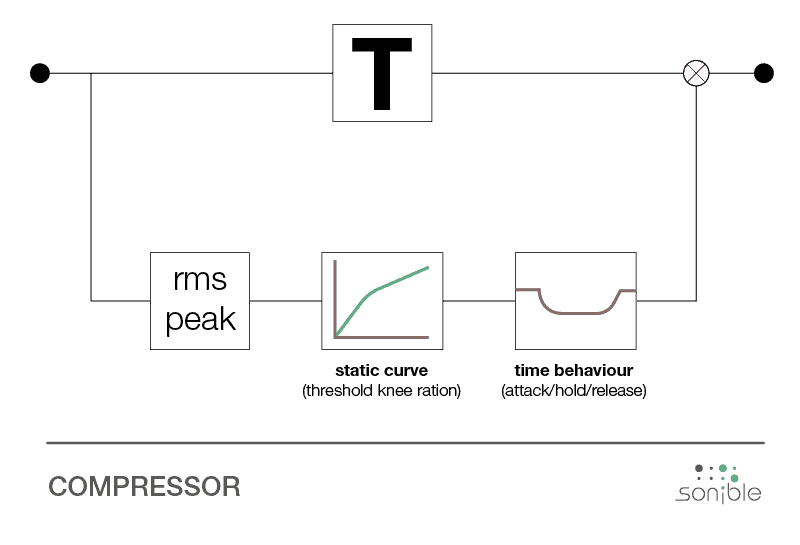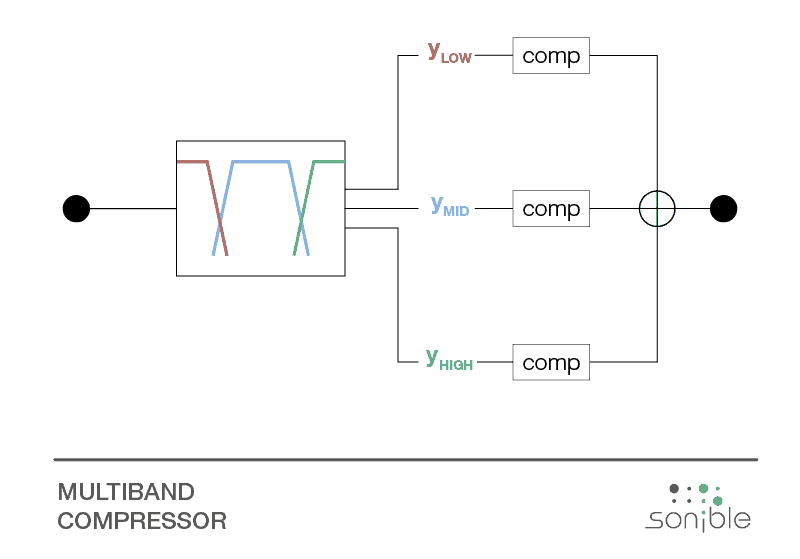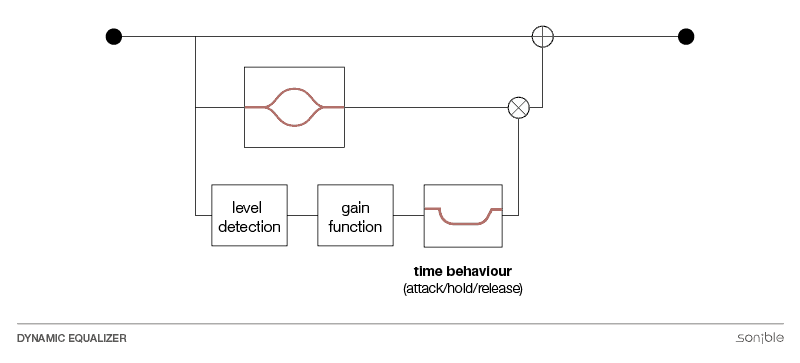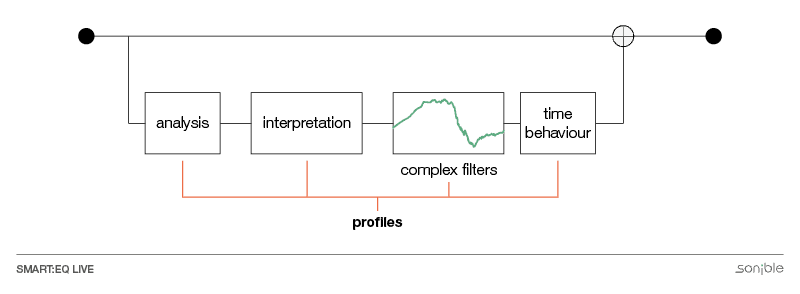But how do those different forms of plug-in work in detail? Which one is the best for such different sound sources as human voice, sums, bus signals or electric guitars and basses? Which possibilities offer the new technology of adaptive equalizers? Here are some answers.
Compressors process the dynamics of a signal by reducing the volume of loud sounds or amplifying quiet sounds thus reducing or compressing an audio signal’s dynamic range. In the special case of multiband compressors, a filter bank separates the incoming signal into different frequency bands before it hits several individually controllable compressors. Their bandwidth determines how these individual compressors are distributed across the entire sound spectrum.

For each frequency band, a multiband compressor typically works in the same way as an ordinary compressor. Its temporal behavior can be controlled by the attack, release, hold and look-ahead parameters, while the transfer function is controlled by the threshold, knee, ratio and make up gain parameters.

Multiband compressors are particularly suitable for the isolated processing of certain frequency ranges in variable signals. This is useful on all sum signals – such as master bus, mastering, and instrument groups. It is possible that low frequencies can be compressed in such a way that the mid and high frequencies, instead of being perceived in proportion to each other, sound quieter; thereby causing the overall mix to lose its brilliance. In this case the multiband compressor allows a detailed weighting of individual frequency ranges and then combines the individual parts together.

Dynamic EQ is basically a conventional parametric equalizer, which is “dynamic” because the otherwise static gain of the filter is replaced by a dynamic control loop. Parameters such as frequency and quality (Q) remain the same. Depending on the design of the control loop, a dynamic EQ can have level-dependent parameters (over/under, threshold, and range) as well as temporal parameters such as attack, release and hold.

Dynamic EQ is ideal for compensating dynamic-dependent changes in sound. For example, voices can overemphasize and sound sharp in the upper frequencies during loud passages. When a certain audio level is exceeded, the dynamic EQ intervenes and regulates it.
In quieter passages, the EQ leaves that same frequency band untouched so that the voice does not lose any additional presence. Inversely, it can increase the frequency band in quiet passages so that the voice does not sound too dull. This means that the voice sounds comfortable at all volume levels without losing pressure.
As dynamic tools, both the multiband compressor and dynamic EQ react to changes in the audio spectrum of the signal. Unfortunately, these changes and the critical frequency ranges in which they occur cannot always be predicted accurately. Especially when mixing live. The two tools described above increase the audio engineer’s flexibility considerably, but unforeseen things can still happen on stage. To better handle these unpredictable situations, sonible has developed smart:EQ live. This adaptive Equalizer is not based on classic electronic circuits, but on a music-analysis algorithm that “understands” what is going on at the moment.
“The music-analysis algorithm ‘understands’ what is going on at the moment.”
smart: EQ live is an adaptive software EQ that compensates for deficiencies in the frequency spectrum in real time. It uses certain processing modules that can only work in the digital domain. In contrast to the previous examples, which basically consist of filters and volume control, this class of adaptive EQs is breaking new ground. They interpret the audio signal musically and then suggest a constantly adapting filter curve to apply. The user can weight these filter curves individually within the signal’s frequency spectrum.

First, profiles inform the plug-in about the nature of the sound source. Accordingly, the plug-in then begins to independently and continuously adjust the frequency spectrum. Thanks to an extensive parameterization of the algorithm, the user always keeps control over the process.
Among other things, it is possible to prescribe a certain time behaviour for the system by means of adaption times. The user also specifies the bandwidths and how they should respond to the filter curve. These individual bands do not force the signal through fixed filters. Instead, the filter curve runs seamlessly across the entire spectrum and reacts only where necessary.
The main difference between a multiband compressor and dynamic EQ and smart:EQ live is that with the latter the user “just” sets a certain direction – a musical framework for the smart: EQ to work within. From then on, the plug-in adapts automatically to the signal. The detailed and complex filter curve continuously adjusts itself and provides a balanced sound in every situation. “Set and forget” you could call it. In this way, the plug-in covers practically every possible sound situation because it does not focus on parameters but instead works by being aware of the overall audio content.
“smart:EQ live works content-aware instead of focusing on parameters and therefor covers basically any sonic situation.”
For example, if you only want to correct the “nasal” timbre of a singing voice in loud passages, it is sufficient to allow fast adaptation only in the midrange since no rapid spectral changes are expected in the low and high frequency ranges. Slower adaptation times would ensure a more stable overall sound. Longer adaption times are suitable for controlling electric basses, which are rather static but can produce momentary plucking or slide noises.
smart:EQ live is not only prepared for any situation but always delivers musical results. The plug-in adds brilliance to vocals and can function as a de-esser at the same time. It handles electric guitars that switch between clean and distorted or balances the master bus.